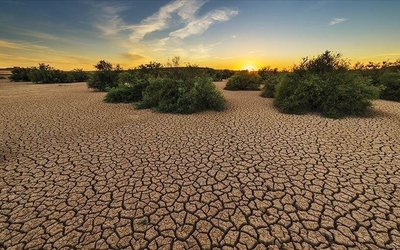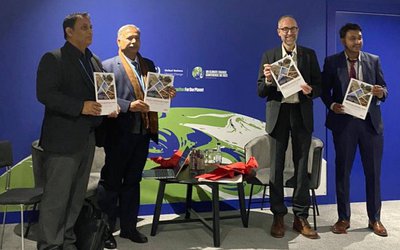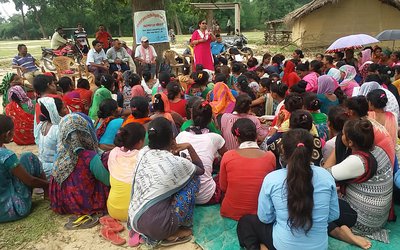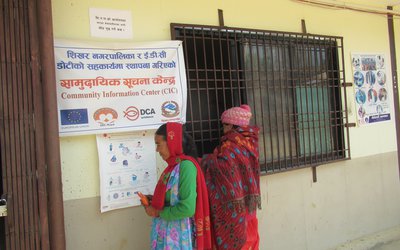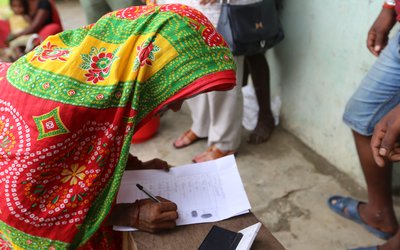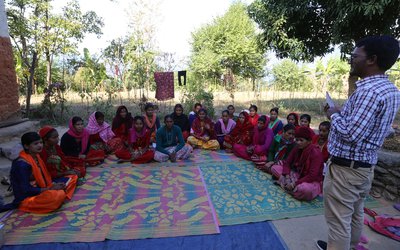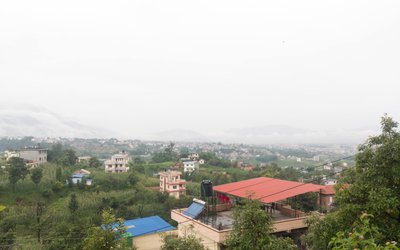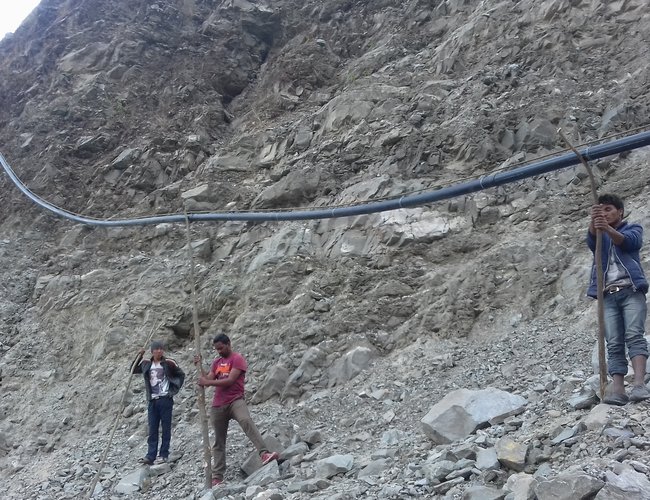
Almost after the three years, most of the regions devastated by the earthquake of 2015 are yet to recover fully. Thanks to Lutheran World Federation Nepal (LWF-Nepal) in partnership with BATAS Foundation and support from Islamic Relief Worldwide (IRW)-Disaster Emergency Committee (DCC), the community of formerly Ramche VDCs currently Ward No. 1 of Kalika Rural Municipality and formerly Yarsha VDC now 1, 2 and 6 Ward of Naukunda Rural Municipality of Rasuwa are almost back to normal with the resilient shelters, infrastructures and livelihood under Build Back Better (BBB) approach
1. Toilets Change Lifestyles And Sanitation Behavior
The earthquake devastated badly the life of fifty years old Kaisya Tamang, a resident of Kalika Rural Municipality – 1, Ramche of Rasuwa District. Her house was demolished and property destroyed as well. The recovery program implemented by Lutheran World Federation Nepal (LWF-Nepal) in partnership with BATAS Foundation and support from Islamic Relief Worldwide (IRW)-Disaster Emergency Committee (DCC) brought drastic change in her life of frustration and anger.
An inclusive toilet ended the long pain of Tamang, a
person with disability, of going for open defecation. Unlike other persons, she
needs an open space to sit and stand.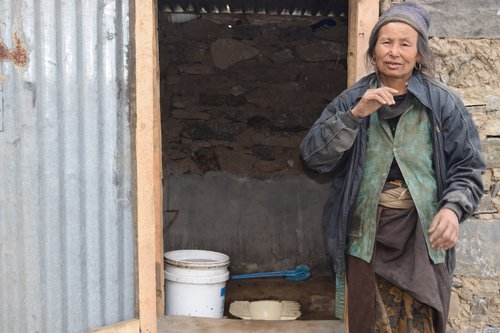
Living with her son, Tamang, a person with disability, has built a house on her own. The decision to choose her as a beneficiary for the toilet made her happy.
“Two months ago when local community told me that these three institutions decided to build inclusive toilet, it was one of the happiest day in my life. With the inclusive and disabled-friendly toilet at home, I don’t have to use local open space to support me,” said Tamang.
Tamang shares that Ramche village used to adopt various traditional practices traditional healers, open defection, simply cleaning dishes and keeping in sun light after meal, no water for dehydration patient eating vegetables and fruits without washing and no hand washing before meal.
As the village was declared no open defecation last month, the construction of toilet turned as a boon, said Tamang. Not only Tamang, every household has a toilet and some of them are inclusive and they are properly used. The local translates the messages of using toilet and other hygiene behaviors to the neighboring village as well during their personal visits. The walking paths and school premises are free from feces and bad odor.
Household cleanliness such as solid waste management, proper dish washing, converting food and water are being practiced in every house. The children are neat and clean, concerned for their personal cleanliness and they do regular hand washing. One of the things the toilet brought is the level of awareness as all the people are aware of water born diseases like stomach ache, dysentery, and diarrhea.
“Construction of toilet has changed our life. There is no more disease,” said Tamang. “Although earthquake destroyed our property and demolished our homes making us homeless, the toilet gives us new healthy life.”
“Along with the construction of toilets, the people from BATAS also taught us the way to remain healthy with hand washing with soap before meal, after visiting toilets” said Tamang.
2. Foot-Trail Helps Farmers To Increase Connection
Although Guranse Village is just two kilometers from
Ramche market and known as a pocket area of vegetable production, the earthen
road, lack of irrigation and adequate knowhow on modern agriculture method
remained as a stumbling block,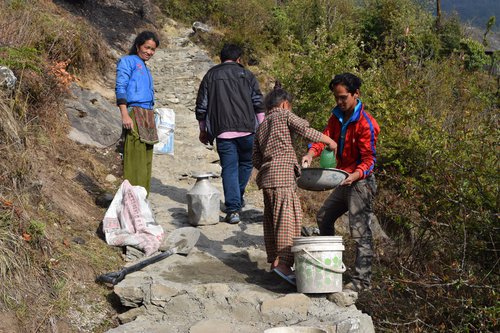
Connected to Nepal’s different city through Pasanglamu Highway, the residents of Guransh Village of Kalika Rural Municipality-1 have everything to make money. However, the steep earthen trail, a small stream, lack of irrigation and modern agriculture method always stood as a barrier for economic prosperity for 150 households.
Implemented by LWF Nepal in partnership Batas Foundation and supported by IRW-DEC, they also constructed the water intake to store the water to use for irrigation purpose. Under the farm program, these organizations have been supporting the local farmers providing seeds of vegetables, plastic sheet, bamboos to build tunnel to grow vegetables.
Taking adequate mitigation to protect the trail from
flood and landslide with Gavin wall, the Construction of 1600 meter
Ramche-Guranse foot-trail of Kalika Rural Municipality-1 is going to be game
changer to develop the hill as a pocket for vegetable production.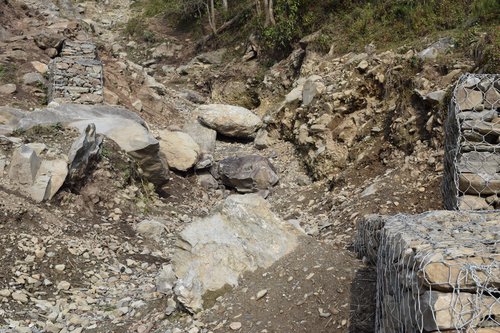
During the rainy seasons, the link between Guranse and Ramche was usually cut off due to flood in the stream and it was always risky to walk. With the construction of concrete steps along with stone wall, people of Guranse will heave a sigh of relief. “The foot-trail has already reduced our travel time between Ramche market and Guranse,” said 78 years old Nema Wangdi. “With the steps, I found much easier to go down and ascend to top. It took me just one and half hours to make a trip.”
Planting vegetables in his 15 ropani of land, Nima saved Rs.60, 000.00 last year. “With the all weather concrete trail before us, it saves our time and energy,” said Nima.
The trail has also certain peculiar character. Following the guidelines of Build Back Better (BBB), adequate mitigation measures were taken during the construction period. As the project was selected with the decision and demand of elected representative of ward 1 and community user group, local people are actively taking part in the construction.
With resting places built for the load carrier in two places, the foot trail is likely to make a difference in the Guransh Village. With 300 students, the trail also helped students of Temrang Primary School.
Along with Wangdi, the foot trail is likely to help
over 150 households in the areas who are growing vegetables. Fifty-seven years
old Menjin Yalmo Tamang is one of the beneficiaries of the foot trail and
irrigation scheme. Tamang, an earthquake victim, received materials for
construction of tunnel, vegetable seeds and fertilizers.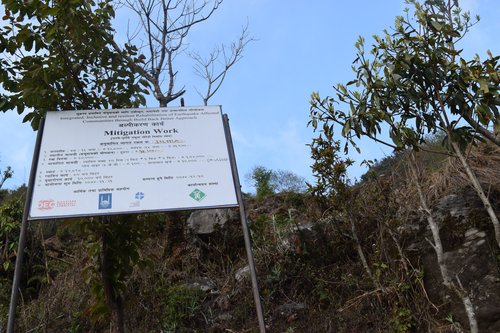
“My vegetable is at the phase of harvesting, I am considering making Rs.50, 000.00 per session,” said Tamang. “With the completion of all weather trail and irrigation scheme, the vegetable farming is going to help us to improve our livelihood.”
Her confidence level is high because the project also took them for observation trip to Trishuli market. “We meet some vegetable vendors of Trishuli and they had shown interest to come to our village to buy the vegetables in bulk,” said Tamang.
3. Drinking Water Supply Reduces The Burden
Women of Palep Village of Kalika Rural Municipality used to spend two hours to fetch a bucket of water. Following the earthquake, the situation further deteriorated with disappearance of water sources. They were compelled to spend hours to get a bucket of water. After the demolition of home by earthquake,Yodarshe Tamang Ghalan,51, chairman of Palep Drinking Water and Sanitation User Group of Kalika Municipality-1, has been living in temporary shelter with reconstruction of new house close to complete. He is happier with construction of water tank with a capacity of fifteen thousand liter and with the support LWF Nepal in partnership Batas Foundation and supported by IRW-DEC. The completion of fifteen thousand liter capacity water tank and water distribution system reduced the burden of women.
“Now we are distributing drinking water to ninety
houses. Under this project, we installed 15 water taps and we rehabilitated 8
old taps, which had dried following the earthquake,” said Ghalan.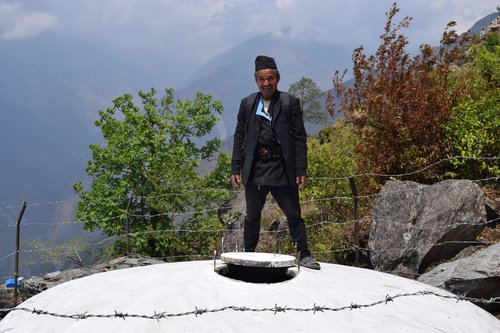
With the water available, all the households have already built the toilets. Along with toilets, people have also started to use additional water to grow the vegetables in their garden. Learning from the past experiences, this water tank is round and built with proper mitigation and protection.
2500 meters below Pasang Lahamu Highway, it normally takes three hours to reach the Grang Market and farmers like Ghalan is also planning to grow vegetables to sell in the market.
With unavailability of water to irrigate the land, farmers of Palep are planting traditional crops like tomato, wheat and corn. “Looking at the availability of water at source, what I can say that we would have some sort of water for the irrigation as well. This means we can grow cauliflower, cabbage and garlic,” said Ghalan.
Chosen with the consultations of Kalika Rural Municipality and chairperson and members of ward 1 and demand of local community, the water intake and distribution line was constructed to protect from landslides and earthquake.
“We constructed the tank and distribution system with constant monitoring and guidelines given by technicians from Batas. We chose a very sound place for water tank and distribution pipes are buried well,” said Ghalan.
Although the past two years was painful for the residents of Palep as they used to spend two to three hours to fetch drinking water, the construction of drinking water project not only ended the burden of women but it also opens the opportunity to grow the vegetables.
4. Grocery Sustains Livelihood Of Single Woman
Earthquake of 2015 brought a number of miseries in the life of thirty-three years old Pode Kamisya Tamang of Thandur danda village of Naukunda Rural Municipality-1. Mother of three children, Tamang has not only lost her house but also lost her husband, the bread earner of the family.
For a few months, Tamang and her four children
survived on the food distributed by various organizations under the relief
package. Living in temporary shelters for years depending on the food provided
by brothers and sisters, Tamang, a single woman, faced many hardships.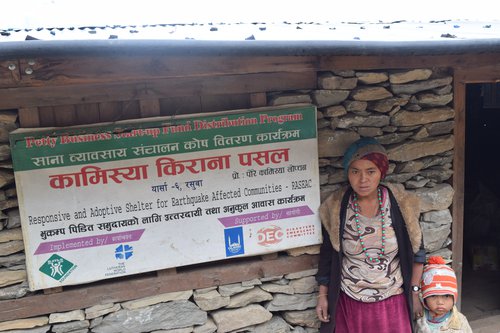
Given her socio-economic conditions, the community and the local level recommended her name as eligible victim to secure 20,000.00 (twenty-thousand) to start the grocery. This program was also implemented by LWF Nepal in partnership Batas Foundation supported by IRW-DEC.
With twenty thousand seed money, she opened a grocery in the village two years ago. “Since there is no one to take care of me and my family after earthquake, I have been living close to my brother and mother. The support provided by BATAS not only revived my hope but saved my four small children as well,” said Tamang.
Selling rice, potato, noodles and other household products, Tamang is earning Rs.500.00 a day, enough to raise her family and send children to school. “I sell different products with an amount of Rs.3000.00 (Three thousand a day). Since last one year, I have already added twenty to twenty five thousand in my asset in the shop,” said Tamang.
Given no competitor nearby, Tamang has a monopoly business. “Mine is the first of its kind grocery. I have been selling most essential daily used commodities,” said Tamang,
As two of her children are going to school and other
two are on the way, Tamang is now considering adding additional goods. Given my
last two years experience, what I can say is that this grocery is going to be a
bread maker of my children as well,” said Tamang, who is also growing
vegetables in her garden.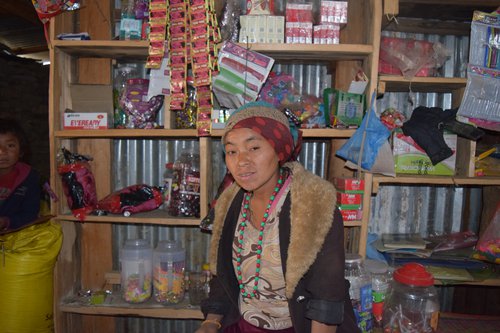
“With a good daily profit margin, my grocery business is growing. First one year following the earthquake was painful and full of trauma and uncertainty. The second two years were of hope and economic sustainability,” said Tamang. “I have already recovered from my pain and agony of earthquake. With the grocery generating profits, I don’t have to worry about the future.”
Tamang has shown the way to run sustained livelihood program. Similarly, these successful experiences have also proved that the joint actions taken by local body, community and civil society organization can bring substantial change in the livelihood of poor people.
5. Combined Strength of Community, INGOs and Elected Local Level have Drastic Impacts
After their micro-hydro, water intake and other infrastructure for drinking water were swept away by dry landslide of earthquake, residents of Thadur Village of Naukunda Rural Municipality-1were compelled to walk almost three hours to fetch a bucket of drinking water.
With no water sources available nearby to meet the demand of water, the local community faced the difficulty to provide enough water to cattle. Many even sold livestock because of unavailability of water nearby.
Under a small support from BATAS foundation, Udeng
Drinking Water and Sanitation User’s Group restored the old pipeline and built
a water tank with a capacity of water tank to supply the water to 40
households.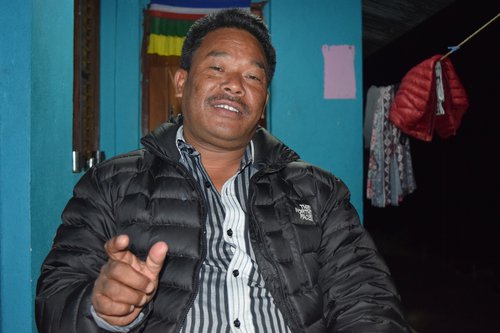
Although rehabilitation of old pipeline solved the problems of 40 households, the large numbers of people living around the village don’t have any access. Since a water source is far away or 3000 meter high above the sea level, the estimated cost of the project was 7.8 million rupees which LWF’s partners alone cannot afford.
Knowing that the community and donor partners facing the budget deficit, newly elected chairman of Naukunda Rural Municipality Norbu Syangbo Ghale agreed to contribute Rs. 3.1 million to a Rs. 4.5 Million fund promised by LWF Nepal in partnership BATAS Foundation and supported by IRW-DEC and community user group agreed to contribute labor equivalent to Rs.600, 000.00.
With a capacity to supply drinking water to 136 households, Udeng Drinking Water Project is now at final stage of completion. Learning from the previous experiences of land slide and earthquake, proper mitigation measures are adopted in the project.
Along with building the earthquake resilient drinking water tank, the project developer also used new method in water distribution pipe. Lying in the deep and steep of rocky mountain, the technicians of LWF and BATAS Foundation applied new technique to protect the pipeline in natural disaster like landslide and earthquake.
“Our drinking water project is first of its kind
constructed with the collaboration and cooperation among NGOs/INGOs, local
elected body and community user group,” said Prem Bahadur Tamang, chairman of
Tokma Muhan Andur Drinking Water Project User Group.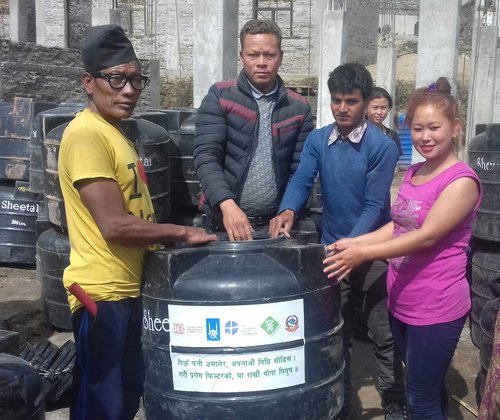
“As you know most of us are farmers, we cannot live without livestock. Along with the humans, the livestock also need water; this project is going to revive entire community giving them water to revive the livelihood. Learning from the past, the newly built infrastructures can cope even major disasters like earthquake and landslide. We have built them so strongly that it will stay in all major disasters.”
Chairman of Naukunda Rural Municipality Ward 1 sees this drinking water project as a model project in Nepal. “This drinking water project has shown that civil society, community and elected local level can work to serve the interest of people,” said Tamang.
As the project is close to completion, Tokma Muhan Drinking Water Project will revive the livelihood people supporting the recovery process in sustained way.
Nima Dawa Tamang, 42, person with disability: Poultry Transforms the Life
6. Poultry Transforms the
Life of People With Disability
Nima Dawa Tamang, 42, a father of three children is a person with physical disability. Living in financially difficult situation with no other employment, Nima’s luck turned when he entered to poultry business. Nima, Resident of Arukharka Village of Nawakunda Rural Municipality-1, has been earning Rs. 12000.00 monthly.
Like all his community, earthquake had badly damaged
the means of livelihood of Nima as well. He lost his house and some cattle in
the earthquake.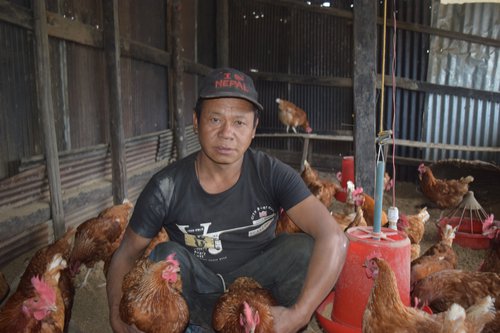
Living in a painful situation with fading hope, Nima’s name was selected by the community to secure the support to poultry farm under a livelihood program implemented by LWF Nepal in partnership BATAS Foundation supported by IRW-DEC.
Under the project, Nima received 46 layer chicks and feeder and other necessary means equivalent to Rs. 38,000.00 to support under a livelihood program, beginning a journey.
Along with providing materials and chicks, the project implemented by LWF Nepal in partnership Batas Foundation supported by IRW-DEC also linked Nima with District Livestock Office for necessary technical support. Nima’s day of generating income started after six months when the chicken started to lay egg.
“In early days, I was a bit worried about the market for the eggs. As soon as my chicken started to lay eggs, the demand is so high that I am not able to meet all the demands,” said Nima. “In an average, I have been selling 35 eggs with Rs.15.00 per piece. I am making net profit of Rs.10, 000.00 a month,” said Nima, who is spending Rs. 1200.00 month to bring feed.
If things go as normal, Nima is planning to add another 50, making his venture of 100 chickens. “We can reach Kalikas market just in a matters of two to three hours, I don’t need to worry about the market,” said Nima.
Earning the money, by selling the eggs, Nima is
currently raising his family members. “I have to expand by poultry farm. Thanks
to LWF and its partner BATAS Foundation, I have found a new way to
make me self reliant,” said Nima.
Although the earthquake has damaged his property and house, the recovery project Implemented by LWF Nepal in partnership BATAS Foundation supported by IRW-DEC showed him a sustainable way of life for the future.
Given access to veterinary service and market at home, I want to continue to rare the chicken in coming days. “Although we used to rare the local chicken, they are not much commercially viable. The lever chicken has changed my economic and social status,” said Nima. The project is implemented by LWF Nepal in partnership BATAS Foundation supported by IRW-DEC.
7. Living In Safe Shelter Ends Worry
Although many of her neighbors in the community are yet to complete reconstruction of their houses, thirty-year-old year Batuli BK, a resident of Langhu village of Naukunda Rural Municipality-1, has been living in her one room earthquake resilient safe shelter with a confidence.
Reconstruction of her house had a history of conflict
with her neighbors who vehemently opposed LWF and its partner package of
building the earthquake resilient house. “ When I signed agreement with LWF and
its partner BATAS Foundation for the reconstruction of houses, my neighbors,
who are seeking cash from the government, threatened to kick out from the
community,” said BK.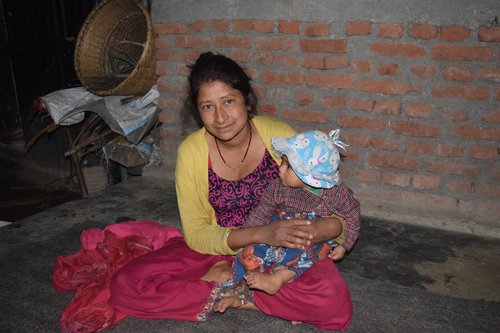
At a time when large numbers of people, who criticized her for accepting the scheme, have been leaving in temporary shelters and constructing the smaller house to secure NRA’s private housing grant, BK, a dalit, has reason to rejoice with her decision.
“I have taken a right decision. Had I ran behind rumor about distributing the money by the government, I would still have to live in temporary shelter. I know that R.300, 000.00 provided by the grant is too small to reconstruct the house. This was the reason I signed for reconstruction of house project implemented by LWF Nepal in partnership BATAS Foundation supported by IRW-DEC,” said BK.
All the 151 houses reconstructed under the shelter program strictly followed the government norm and used all the quality materials. Built under a supervision of well qualified engineers and technical staffs following the Build Back Better (BBB), 172 houses completed nearly a year ago stand with distinct identity.
“Although my house is just one room and I am facing space constraints, I am confident that my house will stand with an earthquake like of 2015. They used all strong materials during reconstruction,” said BK.
Along with houses, BK’s house also included a toilet. This is additional benefits for earthquake victims. Construction of toilet in my house also ends the open deification,” said BK.
At a time when people who were lured to the rumor of getting Rs.800.000.00 cash for reconstruction are regretting their decision, BK finds herself leaving in safe earthquake resilient shelter.
Before reconstruction of houses, the implementing partners also made a land hazard survey whether they could build the houses in old areas. As all the houses were reconstructed with the expert analysis of the land’s condition, the houses reconstructed by LWF-Nepal by its implementing partner are much safe and resilient.
“Looking at the current pace of reconstructed house made by individuals, I feel more comfortable and safe to live. I am pretty sure that my house will not collapse even bigger earthquake than previous one,” said BK. The project is implemented by LWF Nepal in partnership BATAS Foundation supported by IRW-DEC.
8. Mobile Shop Transforms Pasang’s Economic Status
When earthquake demolished his home and destroyed his property, there was a pressure to 26 years old Pasang Tamang, a resident of Ramchi, Kalika Rural Municipality-1 of Rashuwa District. Growing pressure in the family and lack of employment opportunity back home, Pasang was close to leave the country for Gulf.
His entire previous plan has changed following the
meeting with LWF and its implementing partner Batas Foundation. Under a scheme
of LWF, Pasang selected by local community group and elected leaders of ward to
take part in 3 months or 390 days mobile repair training in Trishuli.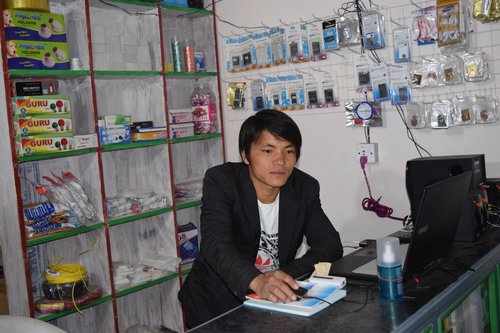
Along with paying training and residential cost, LWF’s partner BATAS Foundation also provided necessary equipment worth of Rs.40, 000.000. With this, Pasang, married of two children, is now operating a mobile repairing Center in Ramche.
“Given the last one month income, I am confident to say that I can earn more money here than going abroad for foreign employment. At a time when everyone has a mobile in their hand, there is good market for mobile maintenance,” said Tamang, whose training is accredited by CTVT.
According to Tamang, he is making Rs. 1500-2000 daily and his net profit is around Rs.1000.00. “The money is enough to take care my family of three. I am also planning to expand my shop adding few sets of mobile,” said Tamang.
Having interest in electronic and electric from childhood, Tamang decided to grab the opportunity provided by BATAS Foundation. The project is implemented by LWF Nepal in partnership BATAS Foundation supported by IRW-DEC.
“I am very much thankful to those organizations which prevent to land in foreign country for employment. My feeling is that I was pushed to the light from darkness,” said Tamang.
With a population of five thousand and city lies in the high way, Tamang hopes to create a good market for his job. As each individual has couple of sets of mobile, I will find enough work to make me busy,” said Tamang.
“I have bitter memories of earthquake and its devastation. However, the earthquake also brings so many things to our village including opening the room of employment,” said Tamang.
9. Farming Garlic As Climate Resilient Crop
As the harvest of traditional crops like potato, wheat
and corn is gradually declining, the subsistence based farmers of Arukharka
village of Naukunda Rural Municipality -1 are planting garlic with a hope to
harvest more and commercialize it to convert in cash.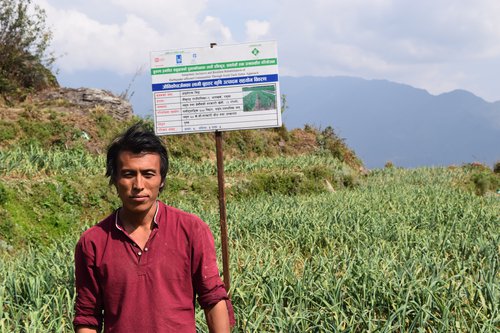
Implemented by LWF Nepal in partnership BATAS Foundation supported by IRW-DEC, the garlic farming is taking shape in the large scale in Arukharka and other villages of Rasuwa district.
Along with the over use of land, the fluctuation in the temperature and rain pattern has been affecting the production of traditional crops declining the productivity every year.
“Looking at the declining of traditional products, my father is hinting towards the abnormal rain and warming temperature. I have decided to plant garlic,” said Aitram Thing, 27 of Arukharka. “Although we are still certain about the productivity and market, garlic has shown that it is suitable climatically in our region,” said Thing.
For the farmers in the region, declining the production of potato, corn, wheat and millet is a major concern. In this scenario, garlic is taken as a replacement for traditional subsistence based crop.
With the initiative of implementing partners, garlic farmers have established direct link with District Agriculture Development Office and vendor dealers from Trishuli.
“DADO’s officials are regularly monitoring our fields along with implementing partners LWF-Nepal, BATAS Foundation and IRW-DEC,” said Thing who has planted 50 KGs of garlic.
The partners provided seeds, fertilizes and other necessary things with amount Rs. 50,000.00. “If the production goes better and we find market, we will expand the areas of garlic farming next year. Looking at my own crop, what I can say that I can make more money from the garlic than the traditional crop,” said Thing.
According to Thing he is expecting to produce 350
kilogram from 50 KG seeds. As harvest is ready by June, Thing is curiously
watching the green harvest of garlic in and around his field. As per the
current market, per kilogram garlic is around Rs.250.00 and per ton are around
250,000.00.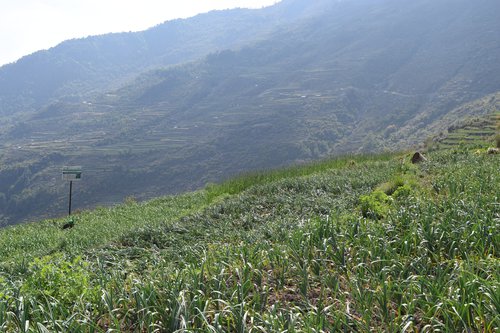
Along with thing ten other farmers have also planted garlic making the entire areas as a pocket of garlic farming in Rasuwa district. Thing holds the view that the farmers of this area expected to produce up to six tons of garlic in coming session.
“After inspecting our field and crop, DADO’s technical officers told us that the growth of crop is quite encouraging. They also suggested the technique to grow more garlic from a plant,” said Thing.
Along with earthquake, Rasuwa district is prone to disaster from climate change and rising in temperature will likely to affect the traditional crop. Although it is very time consuming and needs intense care, Thing believe that this is right time to move for new crop which will bring economic prosperity and climate resilience.
10. Public Bathing Helps Maintain Woman’s Privacy
Women of Thandur Village of Naupokhari Rural Muncipality-1 have reason to be happy. With the construction of public bathing for women near completion, women of Thangdur Village do not have to be hesitated to take bath in front of males.
“With public tap common for man and woman, we rarely find time to take full bath. We are very excited to use women public bathing soon,” said Nurkima Tamang. “This public bath will open us to take full body bath whenever the time is appropriate.”
Although this is purely a new concept in remote
village of Thangdur, there is a visible implication. Women of all ages are
taking part in the construction of pubic bathing for women. There is
a rush of women to complete the work.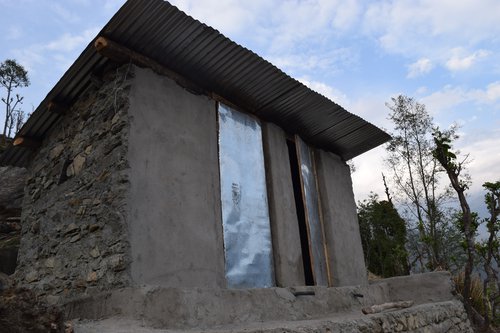
Naturally, male and female need separate bathing space. Unlike toilets, bathing is different matter,” said Nurkima Tamang. Implemented by LWF Nepal in partnership BATAS Foundation and supported by IRW-DEC, women Public Bathing will increase the gender sensitivity.
Binita Thogra, a social mobilizer of BATAS Foundation, sees construction of public bathing will bring a lot of changes in the society with tangible change in women health and sanitation.
Although it is invisible, one can see the pride among women as the numbers of women contributing to construct the bathroom is much higher. With the installation of water tap, the women start to use the women public bathing constructed exclusively to the women.
11. Mason Training Helps Women To Generate Income
As the deadline to complete the reconstruction of house and to secure the third tranche is coming closer, there is a rush in Langbu other villages. There is high demand of mason. Trained a year ago under a mason training program implemented by LWF Nepal in partnership BATAS Foundation supported by IRW-DEC, thirty-three years old Dawa Wangbu Thing Tamang is busy all the time.
Currently working in the construction of Public
Bathing for Woman, Dawa is earning Rs.1200.00 a day as a wage. “Even before
securing training, I used to work as mason. The training has given to me a
chance to enhance my skill and capability,” said Dawa, a mother of three
children.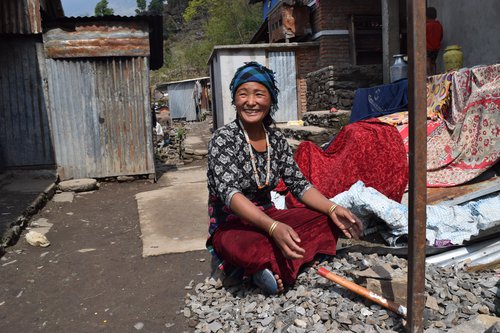
Traditionally, the mason is profession is dominated by male. Even in Langbu’s community, there are only a few male masons with a skill of build back better. However, Dawa is different one. “I reconstructed my house on my own and now I have been working to construct the public bathing,” said Dawa.
Under the On the Job Mason Training for the Women (OJT), Dawa along with other three women completed 50 days training and secured certificate as a mason with a skill to build back better. “Although I have to complete the entire household chorus, I do also work as mason different places,” said Dawa.
Before securing training, Dawa would use the traditional skills and knowledge of wall construction and base. The training program equipped her knowledge and new skills like plasters, construction of concrete beam, tie-beam and making ring.
“There need to follow certain rules and a mason needs to have new skills to make the earthquake resilience house,” said Tamang whose monthly earning is around Rs.15, 000. 00. Under the OJT, other three women also received training. However, Dawa is one of the most busiest and active among them.
“If you remain shy, nobody comes and ask s you for work. One has to prove the capability on his own. Since people knows my skills, they always come to me for work,” said Dawa, who also grinds the concrete and sale them to the village.
“I am very obliges to LWF Nepal, BATAS Foundation and IRW-DEC supporting me to get mason training under OJT,” said Dawa. “ Although many house owners are constructing the house not following the thump rule of earthquake resilience, I have been convincing people the need to use all the materials and follow the guideline of BBB,” said Dawa.
Along with earning money, Dawa has also been promoting the BBB approach which she learned during the training. In her work, she is not strengthening her purse but she has also been suggesting to make earthquake resilience infrastructure.
12. Children Learns to Cope with Disasters
“When the earthquake rocked our entire village three years ago and started to collapse houses injuring and killing people, we all watched the mayhem helplessly. None of our community members has first aid box, stretchers and equipment to dig the collapsed houses,” shared fifty three years Maina BK with a long sigh. Had we have primary things as we have now, we would save couple of people and provide primary health service to injured.”
Although BK’s statement was so much dramatic, she was
telling the real story of April 24 great earthquake. When she was haring early
in the morning with a group of children, middle aged and
elderly man and women of Langbu villages of Naukunda Rural Municipality-1,
everyone were listening quietly at the community building where people were
discussing types of disasters and mitigation measurement to minimize it.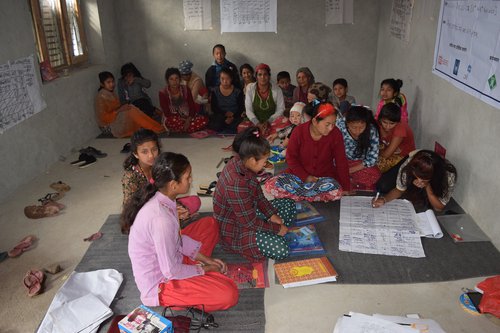
After opening of the discussion by BK, fourteen years old Ajaya Thing, a student of class nine, shared his knowledge about the disaster with the community members.
BK and Thing are not only, Anjana BK, who attended SEE, presented her views on early warning, preparedness, risk, relief and recovery related to various kinds of disasters.
Organized by disaster expert, participants were asked to complete the different tasks regarding the disaster management and disasters preparedness. At the end of the program, they also conducted the mock exercise to prepare themselves from the future disasters.
Raising the level of awareness is a key to minimize the human loss and damage from disasters. As a prone to earthquake, landslide and flood, community of Naukunda Rural Municipality are learning the way to cope the disaster and minimize the damage. Similarly, equipping the community with first aid and basic equipment is another important component for preparedness.
Situated beneath Gosaikunda Mountain range and glaciers, water induced landslides is regularly destroying house land and killing people in the Naukunda Rural Municipality’s ward . After the earthquake, the village has been frequently encountering dry landslides.
Fifty three year BK and fourteen years old Thing was sharing these natural calamities and preparing their community for any kind of disaster in foreseeable future. Holding this kind of program regularly in different parts of the village, efforts are on to raise awareness of people and prepared them at the time of disasters.
“At least people of our community started to understand disaster and they are aware on how to minimize the damage,” said fifty-three years old BK. “The preparedness is one of the important components to minimize the damage from disasters.
Along at the village level, community groups, school children and political leaders are also taking part in various levels of mock exercises with an aim to be prepared for any kind of future disasters.
Along with this, LWF Nepal in partnership Batas
Foundation supported by IRW-DEC has recently handed over some basic
elements to wards of Naukunda Village to use during the disasters.
Raising awareness at community level and equipping the community with the basic equipment, the project is preparing the community, schools, government officials and elected local bodies to minimize risk of disasters and prevent the loss. BK and Thing are two individuals used to raise awareness.
Partnership
and Collaboration In Disaster Risk Reduction
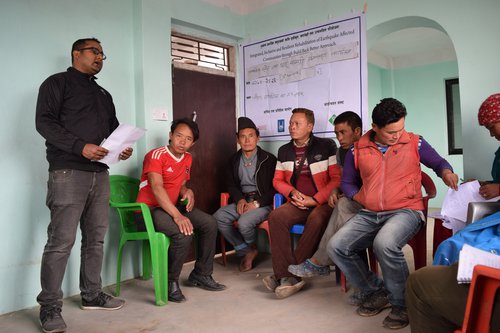
If there is a will, there is a way out. This is what Norbu Syangbo Ghale, chairperson of Naukunda Rural Municipality has shown. Establishing the first Local Level Disaster Relief Fund of Rs. 1.8 million with collaboration and cooperation with the Lutheran World Federation and BATAS Foundation and their supporting partners IRW-DEC, chairperson Ghale indicated his determination to work in collaboration with civil society organization.
“I feel very easy to work with The Lutheran and BATAS Foundation and their supporting partners IRW-DEC. Although there are certain elements in our areas who hold negative opinion about these organizations, I see sharing and collaborating with these organizations is necessary to prosper our village.
Working with these organizations during reconstruction and in the recovery process, Chairperson Ghale has seen their planning and implemented process closely. “ As long as I remain chairperson of Naukunda Rural Municipality, our municipality needs their expertise and experiences to minimize disaster and transform this society.”
Not only Ghale, entire elected representatives of Rural Municipality shared his view. This determination even reflects in their actions in launching and implementing disaster preparedness program.
When LWF Nepal in partnership BATAS Foundation supported by IRW-DEC decided to contribute seed money of Rs 80,000.00 for the establishment of Disaster Emergency Relief Fund, Rural Municipality board has sanctioned one million. Naukunda is the first Rural Municipality to establish Disaster Emergency Relief Fund with collaboration with NGOs and INGOs with amount of Rs. 1.8 million.
“With the technical expertise provided by LWF-Nepal and Batas Foundation, our municipality has also developed guidelines operation modality. We can use this fund at the time of disaster. Since my rural municipality is very vulnerable to natural disaster, Municipality board realizes its importance.
In the past, levels need to wait for District Disaster Committee and Center for relief whenever they need it. This Emergency Fund ends the long tradition. “We need to go to center or other organizations to distribute the smaller relief. With the fund with us, we can use immediately at the time of need. In the past, we used to wait for days to receive relief and humanitarian support from center and other international origination. This comes to an end.”
Along with Emergency Relief Fund, Naukunda Rural Municipality has also a Disaster Management Committee which decides on Emergency Disaster Fund. As par the directive of the government, Rural Municipal Council approved disaster guidelines. The fund was established as per the guidelines.
According to the guideline, the money deposited in the Emergency Fund can be used in relief distribution and recovery. It helps to create local level self reliant on distribute early relief work.
Not only in developing guidelines and establishing fund, LWF-Nepal, BATAS Foundation and their partner organization IRW-DEC also carried out numbers of disaster preparedness and awareness campaigns targeting elected representatives. “They also provided us five days training on how to manage the fund and took class to enhance our capacity to understand disasters issue. We all elected representatives were confused in early days about the words like disaster, relief and preparedness. After attending the class taken by specialist, we were aware able to understand disaster, “ said Ghale. “The mock exercise enhanced our capability understanding various stages of disasters.”
Our experience in the past was very disappointing during the disaster. There used to be District Disaster Committee at the district level which used to delay the distribution of relief to the victims. Now such committee at local level with the technical support from civil society organization, our Climate Change and Disaster Management committee, will function efficiently.
“My experiences have shown that strong collaboration between civil society organization and local level can make a lot of difference. However, this kind of collaboration does not fulfill the interest of those who want to misappropriate the budget. I am defending LWF-Nepal and BATAS Foundation because I have seen their working. As Naukunda Rural Municipality does not have human resources, they have pools of experts, technicians and experienced people and they are very transparent in implementing program. As these organizations are expressing willing to supplement and compliment our programs and projects, it is good for rural municipality to accept it,” said Ghale.
14. Construction of Gabion Wall Protect Irrigation Canal
With the rehabilitation of irrigation with proper
mitigation method, the worries of farmers of ArukharkaVillage of Nawakunda
Rural Municipality -1 have come to an end. Due to lack of mitigation, the old
irrigation system was washed out by the landslides.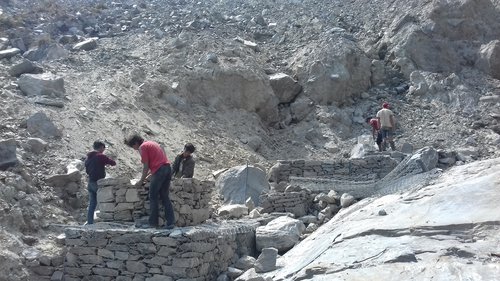
Selected under a request of local community and Naukunda Rural Municipality, LWF Nepal in partnership BATAS Foundation supported by IRW-DEC supported the rehabilitation applying the Build Back Better Approach.
As the project completes, 130 households of Ghyang Tole, Kuna Tole and Ghale Tole will have enough water to irrigate their land as well enough water to drink. With the majority of residence rely on subsistence farming, the irrigation facility helps to increase the agriculture production. The regular irrigation facility will also give opportunity to the farmers to move to cash crops like vegetables including garlic.
“After the earthquake, we have seen several forms of new disasters in and around the area damaging our drinking water intakes and irrigation intakes. Earlier, we constructed irrigation canal not taking in mind the protection, all most all old infrastructures were damaged,” said Khaijung Tamang,50, member secretary of Pangachyasa Khola Irrigation User Committee. The new pipeline and irrigation intake was constructed taking care of state of river and conditions of land,” said Tamang. “We also used 50 Gabon to build wall along with water intake and canal to protect the irrigation scheme,” said Tamang.
Following the demolition of canal and lack of water, farmers returned to grow traditional crop like corn, potato, millet and wheat. “ As our village is very close from the Kalika Bazaar, we are thinking to grow the vegetable and garlic in coming session as we have perennial sources of irrigation available now,” said Tamang.
In some of vulnerable areas, the technicians also used polls in the channel to hang the irrigation pipes. Given the vulnerable land with hazard and prone to landslides, the project follows the adequate safety mitigation.
With no irrigation, farmers grow one crop in a session. As the irrigation projects completes and water is coming to their land, the farmers will grow two crops a year. “Since we have cold store nearby, we are planning to plant the vegetables and potato which has high demands in Kalikasthan Market,” said Tamang.
Constructed taking full consideration of Disaster Risk Reduction (DRR) component and Build Back Better (BBB) approach, each and every aspect of mitigation is duly addressed.
“We use rod Anker , cable crossing and Gabon to make the irrigation project sustainable,” said Bhabishya Neupane, Project Manager of LWF. “The participation of the local community during the construction period helped to transfer the knowledge of BBB and DRR to local population. “From planning to design and construction, there involve local user group and elected representative of local level.”
15. Agriculture
Cooperatives Helps Institution Building
At a time when the farmers in the region started to grow the vegetables, they required institutional mechanism to market their products and provide other financial services. Under a program implemented by LWF Nepal in partnership BATAS Foundation supported by IRW-DEC, Temrang Agriculture Cooperative Ltd received support to improve it institutional capacity.
Although the cooperative was established almost three
years ago, it lacks basic infrastructures like table, computer and racks. The
cooperative also has not registered with any government institution.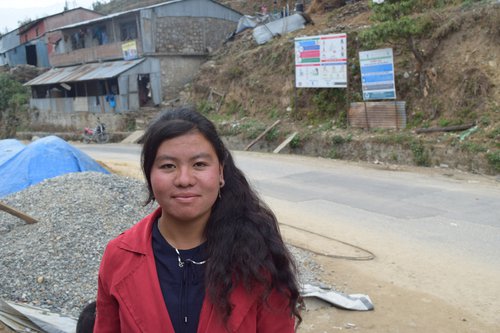
Making institution and strengthening its own capability requires some basic elements. Guiding the cooperatives members about the need to institutionalize, LFW and BATAS Foundation help to register it with District Agriculture Office and get accreditation as an agriculture cooperative.
“Our cooperative is now more organized and functions as a legal entity. LFW and BATAS Foundation have supported us to institutionalize and make as a formal institution,” said Priti Tamang, treasurer of the Cooperative. “We functioned previously as informal institution and now our institution is formalized.”
Under the program, cooperatives received Rs. 150,000.00 to purchase computers and improve its information system to help the farmers supported by LWF-Nepal and its partner organizations.
With capital of Rs.3 million, they are investing money in Ramche Bazaar, Kalikasthan Rural Municipality-1. “We are investing our capital in the areas like vegetable growing, livestock and agriculture,” said Priti Tamang, treasurer of the Cooperative.
“ We provided loan to stationary, mobile shop and agro-farmer under a recommendation of BATAS Foundation,” said Tamang. With 365 members majority of them are women, the cooperatives has been providing loan to small farmers. We provide loan minimum of Rs. 30,000.00 up to Rs.100,000.00.
After getting computer, rack and table, the cooperative has set up its office in Ramche Bazaar. We are support small and marginalized farmers to improve their livelihood through commercialization of agriculture. We loaned farmers to produce cabbage, cauliflower, tomato and potato. We are now working to connect local farmers with other markets like Trishuli, Kalika and Dhunhce to sell their products.”
As numbers of farmer seeking loan to commercialize their agriculture has increased, the pressure on Temrang Agriculture Cooperative Ltd has also grown. However, the support given to strengthen its institutional capacity has been helping the cooperative to work in properly.
16. Support to Shelter and Livelihood Transforms Life of Sonam
As all the victims of earthquake, Sonam Gurung, 28, had lost everything. His house collapsed and grains were buried and landslide washed out his land. At one time, Gurung saw so many upheavals before him.
“I had not imagined that my recovery would be going to be so fast and quick. Implemented by LWF Nepal in partnership BATAS Foundation supported by IRW-DEC, along with Gurung’s, 151 houses was constructed under the Responsive Adaptive Shelter for Earthquake Affected Community (RASEAC) Project. Similarly, under RASEAC, DEC Phase 2b project supported him to open poultry.
Under this scheme, the supporting partners provided
Gurung chick, feed and other materials to operate the poultry. Having one room
earthquake resilient room constructed under BBB approach, Gurung’s poultry has
55 chicken which lay the eggs. In picking period last time, he sold up to 50
eggs with a price of Rs.15 per piece.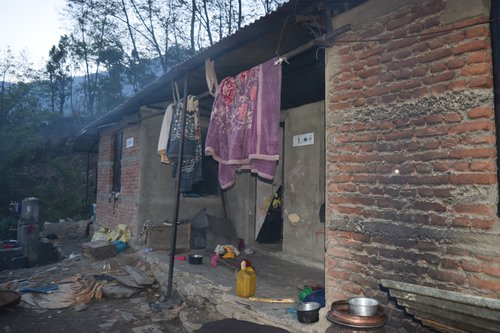
“We are earning enough money to feed our family of five,” said Gurung. As the first batch of chicken is getting old, he is now planning to increase the number from 55 to 100 so that he can make more money. “LWF Nepal, Batas Foundation and IRW-DEC have shown me the way to survive and sustain my livelihood through poultry. Now, I have to show them their contribution is paying to my family,” said Gurung.
Just above the poultry, Gurung has one room house. With adequate income from sustainable livelihood program, Gurung’s life is transforming from an earthquake victims to a successful poultry farmer.
17. Beauty Parlor Training Changes Thinking of Women
Eighteen years old Babita Tamang Thogra a resident ofThangdur village of Naukunda Rural Municipality-1 had never thought that she would be trained as a beautician and start a beauty parlor business.
Implemented by LWF Nepal in partnership BATAS Foundation supported by IRW-DEC, several programs aimed to enhance diversified and resilient livelihood options of targeted households, improved and equitable access to safe drinking water for earthquake affected community, sanitation facilities, strengthened community resilience and mainstreaming Disaster Risk Reduction and Climate Change Adaptation in livelihood, community infrastructure and WASH have already implemented.
Along with much other residence of Kalika Rural
Municipality-1 and Naukunda Rural Municipalit-2, DEC phase 2b under
RASEAC has supported Thogra Tamang to get beautician training.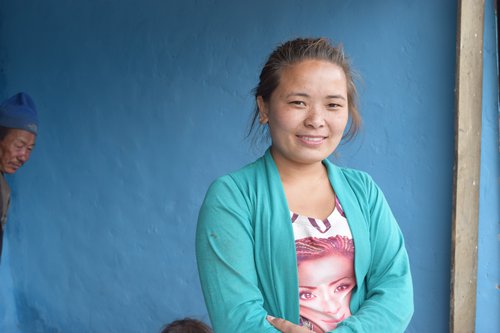
A student of School Education Examination (SEE), Thogra Tamang is not planning to shift to Dhunche, district headquarter, to open beauty parlor. She completed three months training in Trishuli.
With three months training and support of equipment equivalent to Rs.38,000.00, Thogra Tamang is considering to start his livelihood business in Dhunche from next month.
“I have already rented a house in Dhunche and beauty parlor is final stage of completion. I am confidence that I can make enough money to pay rent and cover my livelihood,” said Thogra Tamang.
Unknown about the beauty parlor and beautician skills, neighbors of Thogra Tamang listened her very seriously. Since this is a new profession for me, I have to show to the local people that this also gives sustainable employment opportunity to me,” said Thoga Tamang. “As I joined to new profession, it also changes the thinking of women of our community about the beautician.”

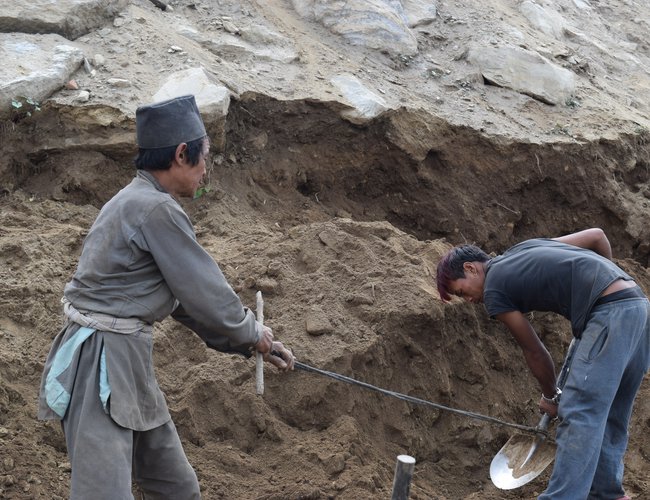
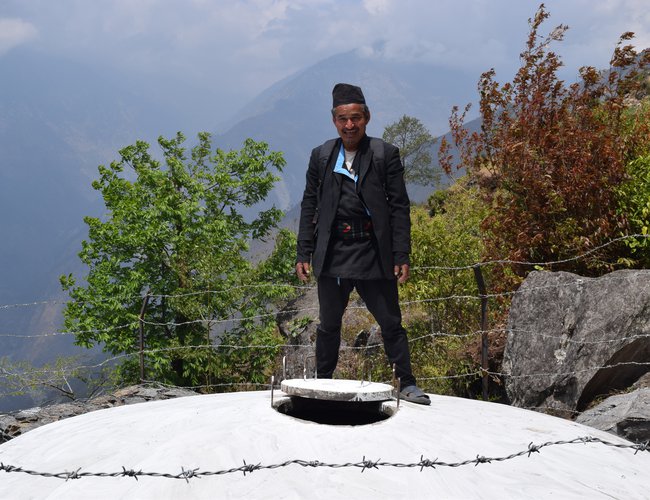
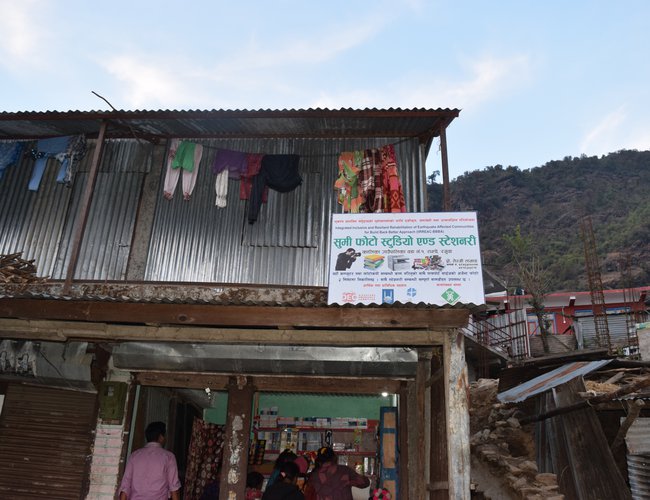
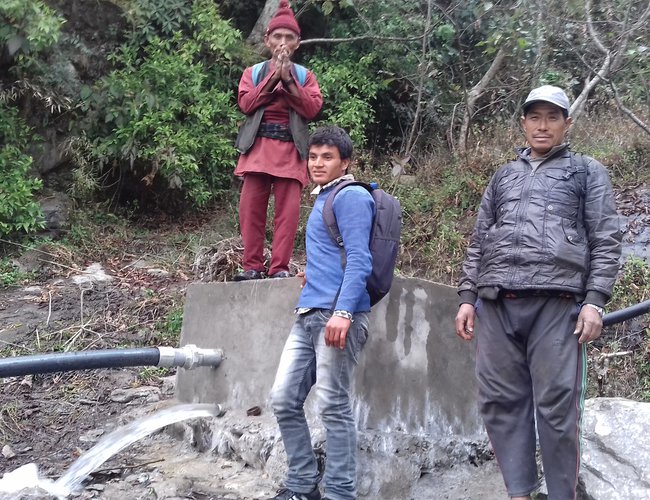
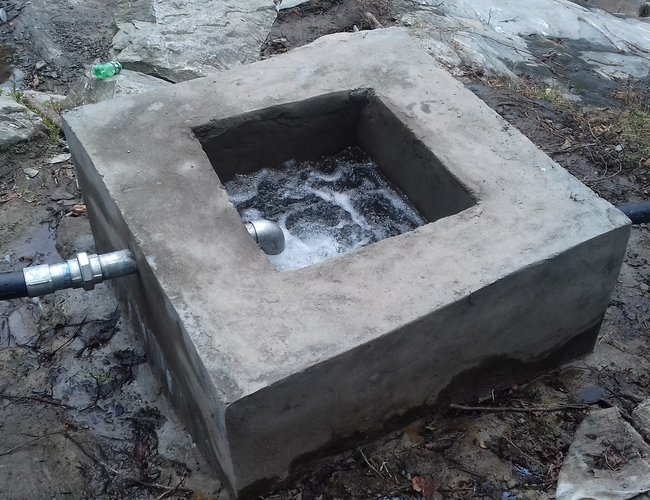
- 139 People Died In The Disaster
- Jul 27, 2024
- Monetary Policy Eases Managing Capital Fund Stress
- Jul 27, 2024
- Weather Forecast: Chances Of Heavy Rainfall Is Likely In One Or Two Places Of Sudu Paschim And Bagmati Province
- Jul 27, 2024
- The Sentiment Of Monetary Policy Seems Focused On Increasing Eemand: FNCCI President Chandra Prasad Dhakal
- Jul 26, 2024
- Monetary Policy 081/82 Is Making The Economy More Dynamic: Governor Adhikari
- Jul 26, 2024

